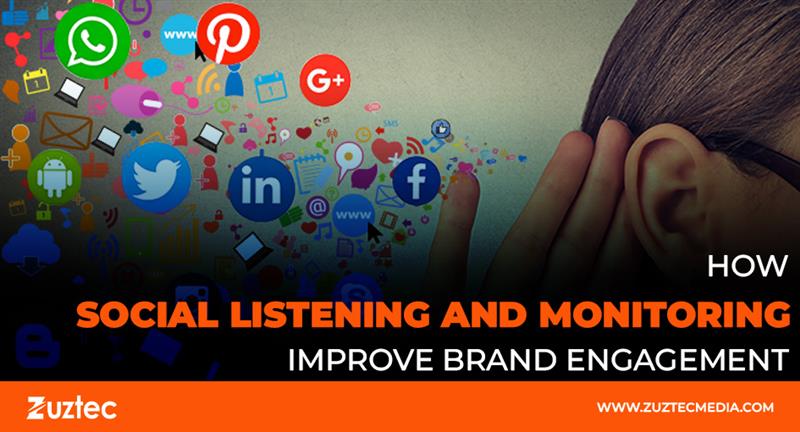
How Social Listening and Monitoring Improve Brand Engagement
In today’s fast-moving digital world, understanding what people say about your brand online is more important than ever. This is where social monitoring and listening are useful. These tools help businesses track online conversations, gather customer feedback, and respond to trends in real time. While they sound similar, they serve different purposes and are both essential for a strong digital strategy.
Tracking mentions of a company, item, or keyword on various social media platforms is the main goal of social monitoring. It’s reactive, allowing businesses to respond to direct questions, complaints, or compliments. Social listening, on the other hand, is broader and more strategic. It involves analyzing trends, sentiment, and discussions to understand the bigger picture. This approach helps brands improve messaging, develop better products, and build deeper connections with audiences.
Together, these practices provide a full view of a brand’s online presence and reputation. They allow companies to stay ahead of public opinion, address issues quickly, and learn from what customers are saying, whether they tag the brand or not. Brands need to pay attention to how audiences respond, what they care about, and how their expectations are evolving.
This article will explore how social listening and monitoring work, the benefits they offer, the tools used, and tips for making the most of this powerful digital strategy. Whether you’re a small business or a global company, these practices can give you the insights needed to grow and succeed.
What Does Social Listening and Monitoring Do
Social monitoring helps businesses keep track of direct mentions on platforms like Twitter, Facebook, Instagram, and LinkedIn. This includes customer service questions, comments, tags, and reviews. It’s all about collecting real-time data and responding quickly. For example, if a customer tweets about a late delivery, your team can step in to offer help. This improves customer satisfaction and shows others that your brand is responsive.
This practice is vital for managing your brand’s reputation. Negative comments can spread fast online, so being able to catch and address them early can prevent a crisis. It also helps identify loyal customers who deserve appreciation, strengthening relationships and encouraging repeat business.
While monitoring focuses on individual messages, social listening is about understanding patterns. It involves collecting data from many sources and analyzing it for sentiment, themes, and trends. Businesses use social listening to learn what people are saying about the industry, competitors, or related topics, even if the brand isn’t mentioned directly.
This allows companies to improve products, find new content ideas, and adjust campaigns to match audience interests. For instance, if many users express frustration about a common problem, your team can respond with a new solution or feature. Social listening gives you the “why” behind what people are saying, not just the “what.”
Benefits of using both together
Combining listening and monitoring gives you a complete view of your audience’s voice. You can respond to individual customers while also learning from overall trends. This makes your brand more agile, informed, and human.
Some key benefits include
- Better customer service and faster response times
- A deeper understanding of audience needs and opinions
- Improved brand image through consistent engagement
- Real-time feedback on new products or campaigns
- Discovery of emerging trends or industry shifts
Using both tools also helps businesses stay competitive by revealing what works for others and where gaps exist in the market.
Popular tools for social listening and monitoring
Many digital tools can help you manage these tasks efficiently. Some of the top-notch platforms are
- Hootsuite: Good for both listening and monitoring across social platforms
- Brandwatch: Known for strong data analysis and sentiment tracking
- Mention: Useful for tracking brand mentions in real time
- Talkwalker: Combines visual listening, analytics, and AI-based insights
These tools allow teams to collect and analyze data at scale, making it easier to act on insights without being overwhelmed by information.
Best practices for success
To get the most from listening and monitoring, consider the following tips:
- Set clear goals: Know what you want to track—brand mentions, competitors, or trends.
- Stay active: Check mentions and feedback regularly so nothing is missed.
- Look at the big picture: Don’t just count mentions—analyze them for tone and meaning.
- Keep learning: Use what you find to improve products, content, and marketing.
Consistent use of these practices can build stronger brand loyalty and lead to smarter business decisions over time.
However, social listening and monitoring are no longer optional—they’re essential tools for any brand that wants to grow in today’s digital space. By combining the real-time response of monitoring with the broader insight of listening, businesses can stay ahead of trends, engage meaningfully with their audience, and make informed decisions.
These strategies offer more than just data—they offer understanding. When you know what your audience is thinking and feeling, you can create better experiences, avoid mistakes, and stand out in a crowded market.
In a world where every post, tweet, or comment can shape your brand’s future, staying tuned in to your audience is not just smart—it’s necessary.

